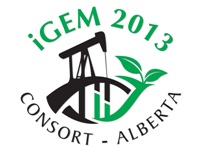Team:Consort Alberta/project
From 2013hs.igem.org
Revision as of 19:46, 20 June 2013 by Kris Glacier (Talk | contribs)
Application/Technology:
Components for the application of our project:
- 1) Power source – to power the heater and the pump.
- 2) Heater – to heat up our sample so that the xylene vaporizes and we can draw it into our E.Coli solution.
- 3) Pump – to create a slight vacuum so that the aromatic xylene is bubbled into our “E. coli box.”
- 4) E. coli box (sealed) – to hold the E. coli as well as keep it in a dark environment so that we can see the fluorescence. It would have a hole on the side for the UV flashlight (it would be a sealed hole) as well as one on the top to see the fluorescence (also a sealed hole).
- 5) UV flashlight – to make the GFP fluoresce.
- 6) Tubing – to connect the heater to the “E. coli box” and the “E. coli box” to the pump.
- 7) Funnel – this will act as a lid for our heater/sample, tubing will be connected from the funnel to the “E. coli box.”
- 8) A wavelength detector – to differentiate the UV and the green fluorescence wavelengths to make sure that there is GFP in the solution (GFP means xylene)
The most practical way of doing this would be to have a vehicle as the power source, so that you can take the components out to the oil well in question and do your test right then and there. This is more efficient than sending it to a lab to have it tested because xylene only has a half life of about 18 hours. This means that the longer you take to test it, the more of the xylene that will degrade, which in turn will give you false/inaccurate results. Also you will need a heating device that is compatible with the power outlet on your vehicle. A travel coffee mug will work nicely for this because its light, cheap, portable, and a funnel can easily be placed on the top of it. Afterwards you would then attach the funnel or lid to a tube which leads to the “E. coli box”, this tube will be submersed deeply into our E. coli solution. This is so that the aromatic xylene will be exposed more effectively to our E. coli, thus giving better results. To cause this bubbling you will need to create a vacuum, this can be done by using a pump (which can also be powered by your vehicle). The intake of the pump would be attached to the “E. coli box” so that it is not sucking up any of the E. coli solution. The “E. coli box” itself will need to be encased in a black box so that when you go to see the fluorescence it is visible. This box will have an eye hole and on a side perpendicular, a UV flashlight will be attached so that the GFP will fluoresce. Since the green fluorescence might be hard to see with your eyes, we would have a wavelength detector so that you can differentiate the UV and the green fluorescence.
E. coli Plasmid Design:
Components for our first plasmid DNA sequence (Total size is 5708Bp):
- 1) BBa_I723021 (2282Bp) (created by iGEM07_Glasgow) – which is a composite part containing the Pr promoter, BBa_I723018, which is the naturally-occurring (possibly stationary-phase only) promoter for the XylR gene (which encodes the transcriptional regulator XylR). The next part in this DNA sequence is the RBS for XylR, BBa_I723019, also the naturally-occurring RBS found in the regulatory region of the XylR gene. Next is the actual XylR coding region, BBa_I723017, where the protein XylR is synthesized. The protein encoded by XylR recognizes the chemical xylene (a petroleum derivative commonly found as a pollutant near industrial sites) and undergoes a conformational change allowing it to bind to, and positively regulate, the Pu promoter. XylR, therefore, should be used in combination with Pu promoter to achieve a switch that activates in response to xylene. Lastly this sequence has the double terminator, BBa_B0015, which is used as the stop codon for this sequence.
- 2) pSB1AK8 – this is the plasmid backbone will we be using for our plasmid. It has both AmpR and KanR which are the bacterial resistance genes to ampicillin and kanamycin. We need bacterial resistances so that we can use those antibiotics to kill off any unwanted E. coli or other invading bacterial without harming our wanted E. coli. Along with these resistances, there is a kill switch attached to the backbone. This kill switch, BBa_P1010, has a half life of 2 hours, which means that in 2 hours about half of the cells should be dead.
Components for our second plasmid DNA sequence (Total size is 4610Bp):
- 1) BBa_I723020 – this is our Pu promoter, when the protein encoded by XylR comes in contact with xylene it goes through a change allowing it to bind to, and positively regulate, the Pu promoter. Basically it starts the process of our RBS to do transcription for of sequence to mRNA and then through translation the GFP is synthesized.
- 2) BBa_B0030 – our next piece, RBS.1 strong, is where the actual transcription will start.
- 3) BBa_E0040 – the GFP wild-type, this is the gene that causes our E. coli to glow when exposed to UV light.
- 4) BBa_B0015 – lastly we have our double terminator, which acts as our stop codon for this DNA sequence.
- 5) pSB1AK8 – same backbone as before so that we don’t by accidentally kill off any of our wanted E. coli
 "
"
